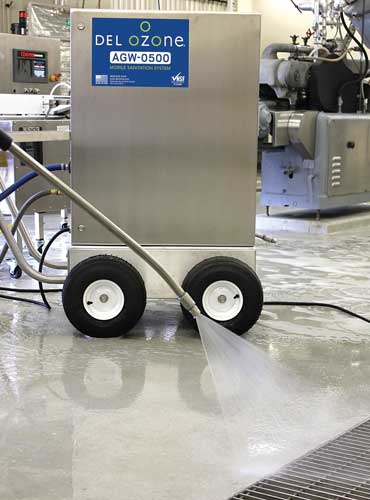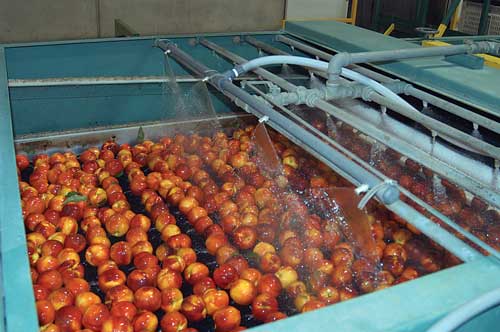Ozone Processing of Foods and Beverages
PROCESSING
Ozone has a long history of use as a disinfectant in food and beverage processing. In the United States, the application of ozone to disinfect bottled water was approved as Generally Recognized As Safe (GRAS) in 1982. Later it was approved as a sanitizing agent for bottled water treatment lines. Ozone processing of foods has been allowed in Australia, France, Japan, and other countries for some time. Yet application of ozone for direct contact on foods was not approved as GRAS by the U.S. Food and Drug Administration (FDA) until June 2001 under the FDA Final Rule 21 CFR Part 173.336. Later that year the U.S. Dept. of Agriculture’s Food Safety Inspection Service approved ozone for use on meat and poultry products. Since then many commercial systems have been installed. These systems use ozone as an antimicrobial agent for direct contact with many types of foods. Ozone is also listed in the National Organic Program final rule, which permits its use in processed products labeled as organic or made with organic. This month’s column will provide an overview of ozone processing in the food industry.
Ozone Chemistry
Ozone is one of the most powerful oxidizers available. It is a highly reactive, gaseous form of oxygen, consisting of three oxygen atoms. Ozone is most commonly known for its role in the stratosphere where it is generated naturally and functions to protect the Earth and its inhabitants from harmful radiation. Ozone is also formed during lightning discharges in the atmosphere. It is a colorless gas at low concentrations under ambient conditions.
It is a potent disinfectant. Ozone decomposes into hydroxyl, hydroperoxy, and superoxide radicals. The degradation of ozone into these free radicals provides very short-lived compounds with strong oxidation potential. Direct reaction with ozone also provides oxidation. Through these oxidation reactions, ozone can inactivate a wide range of pathogens including Salmonella enteritidis, E. coli O157:H7, Listeria monocytogenes, Shigella dysenteriae, and Chlostridium botulinum, as well as a variety of yeasts, fungi, viruses, parasites, and molds. Ozone inactivates microorganisms by reacting with oxidizeable cellular components, such as double bonds, sulfhydryl groups, and phenolic rings, resulting in cell damage and death of the microorganism. The two main mechanisms of inactivation of microorganisms are through 1) oxidation of sulfhydryl groups and amino acids of enzymes, peptides, and proteins and 2) oxidation of polyunsaturated fatty acids into acid peroxides.
Ozone is particularly effective as an actimicrobial due to its strong oxidation-reduction potential (2.07V), which is higher than chlorine (1.36V). Ozone is also environmentally friendly and leaves no harmful chemical residues. Ozone is soluble in water, and its solubility is affected by temperature, with solubility decreasing with increasing temperature. Although ozone rapidly degrades, it has a longer half-life in the gaseous state than in aqueous solution. Water purity also affects half-life in that ozone degrades more rapidly in impure solutions than in pure water. These properties of ozone are important in designing food processing equipment to generate and treat foods efficiently with ozone.
Ozone Processing
Ozone is a potent antimicrobial agent in both the gaseous or aqueous phase that may be used safely in the treatment, storage, and processing of foods in accordance with current industry standards of good manufacturing practice.Ozone can be generated using photo-chemical or corona discharge (sometimes called plasma) techniques. Although there are other methods of making ozone (electrolysis, radio chemical, reaction of elemental phosphorus with water), these are less utilized.
Ozone generation by corona discharge (CD) is generally created onsite. In this method, dry air or oxygen is passed between two parallel or concentric electrodes that are coated with a dielectric materials. As a result, oxygen molecules are broken down into charged oxygen atoms that then recombine to form ozone molecules. The quality of the air or oxygen fed into the ozone generator is a critical factor that affects both performance and longevity of the CD ozone generator.
Another method of ozone generation is photo chemical through the use of ultraviolet (UV) light. Low-pressure mercury UV lamps at 185 nm wavelength can be used to generate ozone. Feed gas (usually ambient air) passes through the irradiance field surrounding the lamp, and some of the oxygen molecules photodisassociate into oxygen radical atoms that then attach to intact oxygen molecules forming ozone.
 Ozone generated through either of these methods can then be applied to foods or food contact surfaces in either aqueous solutions or in the gaseous phase to decontaminate. Both gaseous and aqueous ozone generators are commercially available. Commercial ozone equipment can be purchased from a variety of manufacturers, including Ozone Safe Food Technologies, Perris, Calif., Ozone Solutions Inc., Hull, Iowa, and DEL Ozone, San Luis Obispo, Calif. In addition, The Ohio State University hosts a number of ozone generators and product treatment chambers in sizes ranging from benchtop to pilot-scale.
Ozone generated through either of these methods can then be applied to foods or food contact surfaces in either aqueous solutions or in the gaseous phase to decontaminate. Both gaseous and aqueous ozone generators are commercially available. Commercial ozone equipment can be purchased from a variety of manufacturers, including Ozone Safe Food Technologies, Perris, Calif., Ozone Solutions Inc., Hull, Iowa, and DEL Ozone, San Luis Obispo, Calif. In addition, The Ohio State University hosts a number of ozone generators and product treatment chambers in sizes ranging from benchtop to pilot-scale.
For aqueous applications, ozone is transferred into water using either Venturi injection or fine bubble diffusion. Venturi injection consists first of a fluid injection nozzle where the water pressure is converted into kinetic energy. The next section is a suction chamber/diffuser section that suctions, entrains, and mixes the ozone into the water. The increase in velocity in the injection nozzle results in a decrease in pressure enabling the ozone-containing gas to be drawn through the suction and entrained in the water. Fine bubble diffusers are usually made from porous stone, ceramic, or stainless steel. Diffusers are used to distribute a fine dispersion of ozone gas bubbles into the bottom of a column of water. The ozone exiting the generator is under pressure and expands as it diffuses into the water.
Since ozone is generated onsite, it eliminates the need for personnel to handle harsh chemicals for sanitation. Another advantage of ozone over other chemical sanitizers is that ozone requires no storage or special handling.
At low concentrations, ozone has a pleasant odor similar to the air after a fresh thunderstorm. At high concentrations, however, the air is objectionable and can pose a health risk. OSHA regulates the permissible levels of exposure in the work environment, and these levels must be controlled and monitored in commercial manufacturing facilities.
--- PAGE BREAK ---
 Applications of Ozone Processing to Foods
Applications of Ozone Processing to Foods
• Direct Food Contact. Ozone can be applied directly on many food types to improve safety and extend shelf life. Foods are treated with ozone in gaseous form, as well as in aqueous sprays and dips. Sanitation of fresh produce is one of the most promising applications of ozone. Ozone is relatively gentle on produce. High levels of ozone can be used before altering the taste or appearance of produce. Another advantage of ozone is that it lowers counts of spoilage microorganisms in wash water in addition to on the produce surface, thus extending the shelf life of the produce while keeping the wash water clean and enabling less water usage. Ozone is also used in seafood processing where it has been used for many years and found to not only improve the safety of the seafood, but also to increase its shelf life. Higher-fat foods like meat and chicken require higher ozone concentrations than low-fat foods such as fruits and vegetables. When treating meat and chicken, excess levels of ozone and resulting oxidation must be avoided so as not to degrade the flavor of the meat and chicken products.
• Surface Sanitation. Another common application of ozone is for food contact surface sanitation. The inclusion of ozone-containing water within clean-in-place (CIP) cycles offers opportunities to food processors to treat manufacturing plant surfaces more efficiently and with greater efficacy. Aqueous ozone can also be used as a sanitizing rinse for food contact surfaces, such as cutting tables, as well as for nonfood contact surfaces, such as floors. Ozone can also be used to treat aseptic food packaging materials for surface disinfection.
• Cold Storage. Ozone can further be used to treat stored grains and other foods to control fungi and mycotoxins, as well as for insect control as an alternative to chemical treatment.
Opportunities for the Future
Interest in ozone is expected to continue to rise in response to consumer demands for environmentally friendly food processing technologies. A recent publication mapped trends in implementation or potential for implementation of ozone in the food industry. It found that ozone scored very high in terms of potential applications for fresh produce, seafood, and beverages. Another potential future application for ozone is its use to degrade pesticide residues, including organophosphates and organochlorinated compounds. As with many process technologies, ozone also has good potential for use as a hurdle technology to be combined with other sanitation and disinfection technologies to improve the safety of foods and beverages while extending their shelf life.
 Tara McHugh, PhD, Contributing Editor
Tara McHugh, PhD, Contributing Editor
Research Leader, USDA Agricultural Research
Service, Albany, Calif.
[email protected]
References
Bhattacharya, S. 2014. Conventional and Advanced Processing Technologies. Chichester, UK: John Wiley & Sons.
Jermann, C. et al. 2015. “Mapping Trends in Novel and Emerging Food Processing Technologies Around the World.” Innovative Food Sci. Emerging Technol. doi: 10.1016/j. ifset.2015.06.007.
Ohio State University Extension Fact Sheet, FSE-5-07. http://ohioline.osu.edu/fsefact/0005.html.
Zhang, H. Q. et al. 2011. Nonthermal Processing Technologies for Food. Chichester, UK: John Wiley & Sons.

